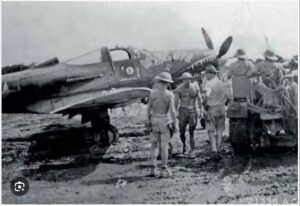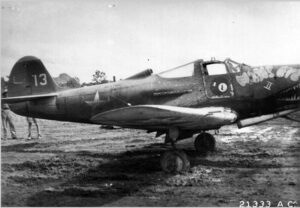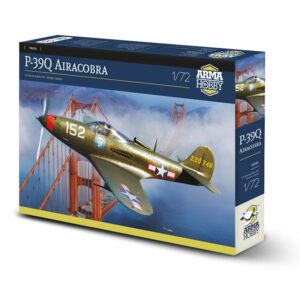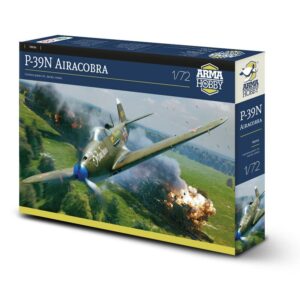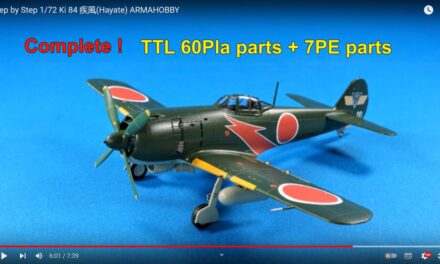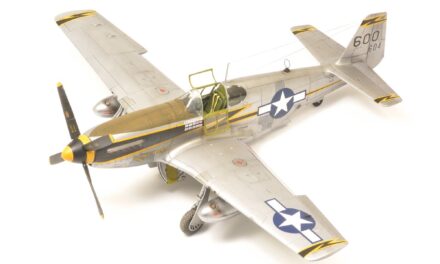
Prior to the outbreak of the Pacific War, the core of the United States Army Air Corps (USAAC) was stationed in the Philippines. It was completely destroyed by the Japanese during the first weeks of fighting. Later, attempts were made to reconstitute USAAC units in the Dutch East Indies on the island of Java, but these forces, too, were utterly crushed by Japan’s unstoppable aerial might. With the defence perimeter resting on Australia and the eastern tip of New Guinea, a third attempt was made to reconstruct US Army aviation in the South Pacific. In the first wave, in February 1942, three fighter groups were flown to Australia. The first of these was the 49th Pursuit Group (Nos 7, 8 and 9 Squadrons), which was equipped with P-40Es and directed to defend Port Darwin. The second group – the 8th Pursuit Group (Nos 35 and 36 Squadrons) – received P39Ds and Fs, and in April 1942 flew to New Guinea to support the Australian defenders of the island’s last redoubt, the town of Port Moresby, which was then the provincial capital of Papua. The third and last was the 35th Pursuit Group (Nos 39, 40 and 41 Squadrons), which was to remain in Port Moresby with the objective of taking over from the “eighth”. And it was the 35th Pursuit Group that was equipped with the P-400s which had been rejected by the British.
“Eight” over Port Moresby
The 8th Pursuit Group’s first encounters with the Japanese over New Guinea did not highlight the Airacobra’s greatest drawback, namely, its inability to fight at higher altitudes. Initially, the group attempted to perform offensive flights and escort Allied bombers over Lae, but this was quickly abandoned and the Airacobras were assigned to intercept enemy fighters attacking airfields around Port Moresby. Engaging Zeroes flying low above the ground was still within the capabilities of the P-39. Encounters were numerous, and were quite evenly matched. Aircraft were lost, but victories were also reported.
P-400 Airacobra „white 13” „Wahl Eye”, 39FS/35FG, pilot Lt. Eugene A. Wahl, Port Moresby, New Guinea, Summer 1942. Photo: Public Domain via Frantisek Sredl
The 35th Fighter Group, stationed in Australia, underwent its baptism of fire during this period (the name was changed from “Pursuit” to “Fighter” on 15 May). On 17 May 1942, while escorting B-26s sent to bomb Lae in New Guinea, 1st Lt Harvey Scandrett from the 40th Pursuit Squadron scored the first aerial victory for his unit over Morobe – and the first victory for the P-400 – by shooting down a Mitsubishi Zero. On 20 May 1942, a group of pilots from 39th Fighter Squadron, which was temporarily assigned to the 8th Fighter Group, surprised eleven Zeros over Waigani. An American, 1st Lt Thomas Lynch, shot down two. One Airacobra was lost in the battle. On 26 May, the 39th Fighter Squadron shot down three more Zeroes, with Lynch once again among the victors. As it later turned out, Thomas J. Lynch would become famous as one of the most successful pilots flying on Lightnings, while also remaining the USAAF’s most effective operator of the P-400, with three confirmed victories.

P-400 Airacobra „white 13” „Wahl Eye”, 39FS/35FG, pilot Lt. Eugene A. Wahl, Port Moresby, Summer 1942
35th Group for relief
On 2 June 1942, the 39th and 40th Fighter Squadrons from the 35th Fighter Group flew to 12 Mile Drome and 14 Mile Drome airfields located near Port Moresby, relieving the 35th and 36th Fighter Pursuit Squadrons from the 8th Fighter Group which were stationed there. However, this coincided with the calming of the situation over New Guinea, and the first encounters after the transfer occurred only two weeks later, on 16 June; in their course, 1st Lt Bernard Oliver from the 40th Fighter Squadron and 1st Lt Francis Royal from the 39th Fighter Squadron each shot down a Zero over Maime. Another victory was reported a day later, but then silence fell over Port Moresby. In July, there were only three air battles, during which six aircraft were reported shot down.
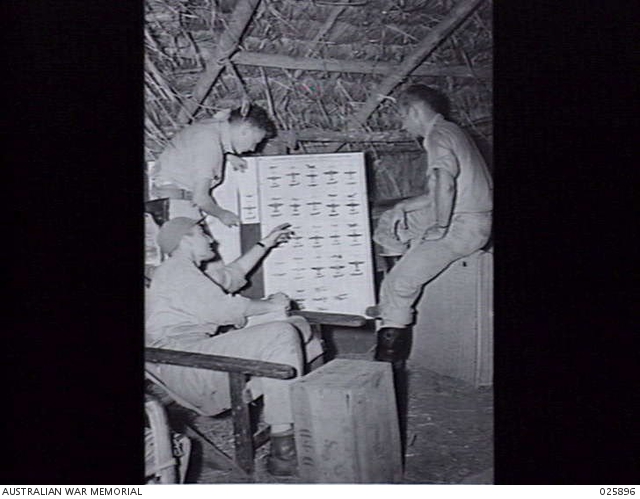
Airacobra pilots are discussing the Japanese aeroplanes silhouettes at Port Moresby base. 11th July 1942
Particularly fruitful for the P-400 pilots was 11 July 1942, when the 40th Fighter Squadron was sent to intercept a Japanese bombing expedition and managed to shoot down as many as four aircraft without suffering any losses. The secret to their success was the Port Moresby surveillance system, which alerted the Americans early enough to give them time to reach a high altitude and swoop down on the enemy force.

Ground crews at rest, 11th July 1942, Port Moresby airfield
Between 20 and 22 July 1942, the 80th Fighter Squadron was deployed to New Guinea in a couple of stages. This new squadron had just been assigned to the 8th Fighter Group, which had so far operated with an incomplete complement of two squadrons. And while the two original squadrons (the 35th and 36th) were equipped only with P-39s, the 80th Fighter Squadron received a mix of P-39s and P-400s. Some time later, the P-400-equipped 41st Fighter Squadron of the 35th Fighter Group arrived in Port Moresby, while the 39th and 40th Fighter Squadrons of the 35th Fighter Group were sent to Australia to rest.
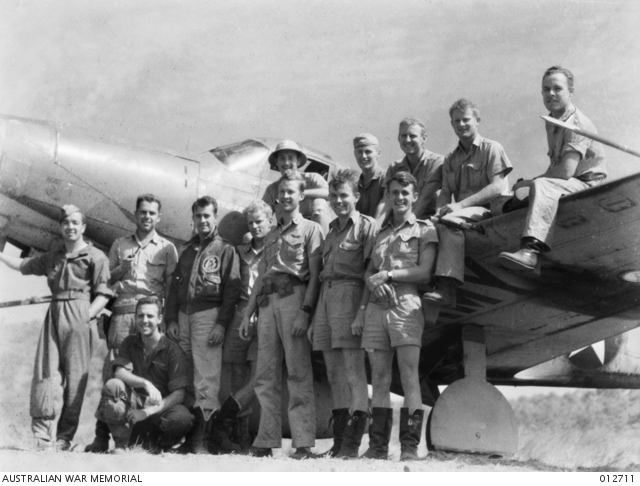
40th Fighter Squadron pilots at Port Moresby before leaving to Australia, end of July 1942
By this time, the Allied’s situation on New Guinea had become complicated, for on 21 July the Japanese carried out a landing at Buna, north-east of Port Moresby. On 29 July 1942, a combined group of P-400s from the 41st and 80th Fighter Squadrons performed their first major offensive action, providing cover for Douglas A-24s (the land-based version of the Dauntless) sent to bomb shipping near Buna. The mission resulted in a bloodless skirmish with three Zeroes. The most notable outcome of this operation, however, was the decision that the A-24s were useless in Army aviation. The A-24 crews were poorly trained, had lost their way and scored only one bomb hit, while as many as five of the seven bombers did not return to base for various reasons.
August fights
In August, it began to dawn on the Americans just how serious a shortcoming of the Airacobra the lack of a turbocharger actually was. By then, the Japanese had resumed air strikes using twin-engined “Betty” bombers flying at altitudes in excess of 25,000 feet (7,600 metres). Every attempt at intercepting these expeditions ended in failure. Pilots also made reconnaissance flights and flew as escorts for B-26s, but these actions rarely led to clashes with the enemy. If enemy aircraft were at all encountered, the battles were fought with varying success. More significant were the P-400 operations against ground targets, which were intended to provide direct support to Australian troops defending against the Japanese. The Airacobras began to be fitted with 500-pound bombs, while others were sent into combat armed only with their on-board weapons. In one instance, a P-400 pilot even dropped his extra fuel tank on enemy positions, and then set it on fire with his machine gun.
On 25 August, the Japanese opened a new front in New Guinea, landing an assault force in Milne Bay, directly east of Port Moresby. But this time, thanks to timely reports from reconnaissance aviation, the Allies were fairly well prepared, and had been gathering forces in the area for a number of days. The skies over Milne Bay were defended by Australian squadrons, while the Americans concentrated on attacking the Japanese airfield at Buna in order to paralyse the squadrons stationed there and thus prevent them from providing support for the Milne Bay landing. During several days of operations, P-400 pilots from the 41st and 80th Fighter Squadrons fought some fierce battles under very favourable conditions.
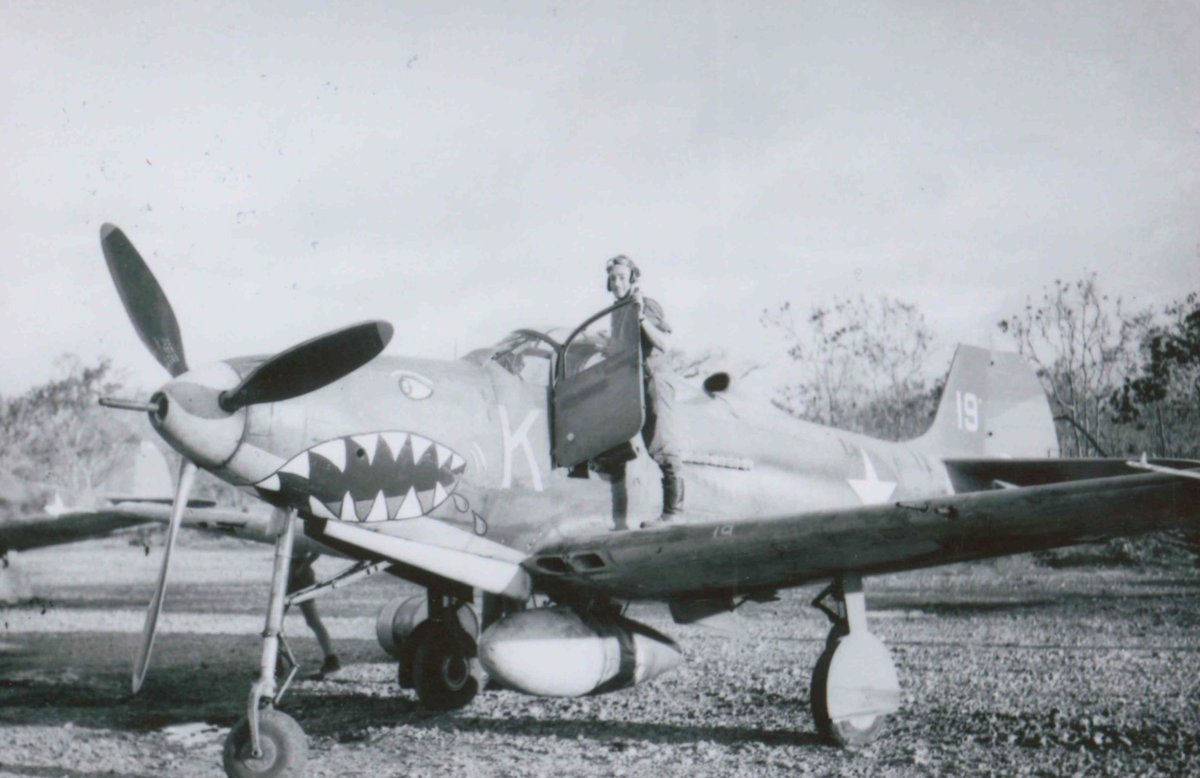
P-400 Airacobra „white 19”, AH736, 80th Fighter Squadron. Photo: Frantisek Sredl collection
On 26 August, ten P-400s from the 80th Fighter Squadron took off to attack the airfield at Buna. No less than four had to turn back to base due to technical problems, but the remaining six flew over the Owen Stanley massif and saw six Zeroes taking off from Buna airfield. The Americans, at speed, went into a shallow dive and soon found themselves between the Zeros; they later reported shooting down all six for the loss of one Airacobra. It was the greatest success achieved by P-400 pilots in combat against Japanese aerial forces. Two of the victories were credited to Daniel T. Roberts, a future Lightning ace.
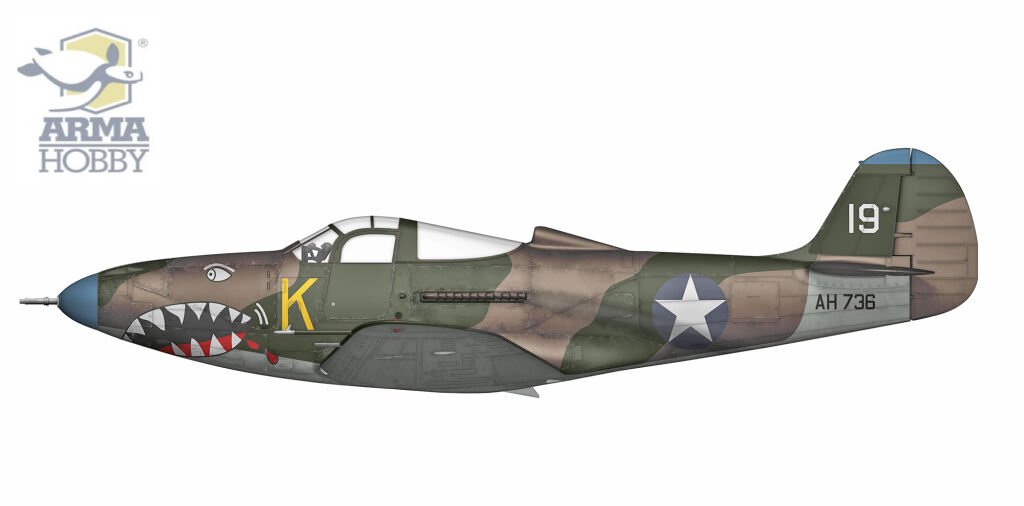
P-400 Airacobra „white 19”, AH736, 80FS/8FG, Turnbull Airstrip, Milne Bay 1942
The following day was nearly as fruitful. In the morning, fourteen P-400s from the 41st Fighter Squadron escorted a formation of B-26s flying to attack Buna airfield. Above the target, the expedition was attacked by ten Zeroes. The Americans hit the Japanese with the advantage of height, and to all intents and purposes took them completely by surprise. After the brief battle they reported five kills for no own losses. These were the first air victories scored by the unit.
Autumn – ground attacks
As it was to turn out, however, the P-400 pilots had to wait many months for the next fruitful air battles over New Guinea. The intensity of operations in September and October was very high, but the focus was on ground targets and flying cover for the bombers supporting Australian troops advancing towards Kokoda. To be sure, on 22 October Airacobra pilots from the 41st Fighter Squadron shot down two Japanese aircraft, but the resumption of intensive air combat occurred only in the second half of December 1942, during a major new Allied offensive.

Ground crews rearming and refuelling Airacobras after the combat sortie. 27th July 1942
At the time, the 39th Fighter Squadron, which was resting in Australia, became the first unit in the South-West Pacific to commence training on the brand-new P-38F. After it was fully re-equipped with Lightnings, all of the squadron’s Airacobras were handed over to the 80th Fighter Squadron.
In the second half of September, the remaining components of the 35th Fighter Group, that is, primarily the 39th and 40th Fighter Squadrons resting in Australia and the newly formed HQ (Command) Squadron, began to redeploy to New Guinea. By 18 October 1942, the 35th Fighter Group was already operating out of the Port Moresby area from 7 Mile Drome, 12 Mile Drome and 14 Mile Drome airfields. The Group’s 39th Fighter Squadron flew the P-38F, while its remaining units operated a mix of P-400s, P-39Ds and P-39Ks.
On 16 November 1942, the Allies launched an offensive towards Buna and Gona with the objective of driving the Japanese from the northern coast of eastern New Guinea. A few days later, on 22 November, pilots from the 41st Fighter Squadron intercepted fifteen Aichi Vals over Buna, escorted by eight Zeroes. When they saw the Airacobras, the bombers immediately turned back north, while the Zeros squared up to the Americans. The foes clashed head-on, and the Americans claimed three victories (one of which was recognized as confirmed) without any own losses.
The last fight…
The final battle in which the P-400 was confirmed to have participated occurred on 6 February 1943, shortly after the enemy was expelled from the mining town of Wau in Morobe province. That day there were a number of air battles with the Japanese bombers attacking the nearby airstrip, which had just been lost to the Allies. In total, the American pilots were credited with no less than twenty-five aerial victories on 6 February, with as many as sixteen being ascribed to the Airacobra pilots. The 41st Fighter Squadron also accounted for some of the kills when one of its patrols, comprising five P-400s and three P-39s flying at 13,500 feet, encountered a section of six Zeroes flying some 5,000 feet below them. The Mitsubishi pilots were taken completely by surprise and four were quickly shot down.


The winners from Wau, 6th February 1942. Robert N. Boucher, Dugan V. Woodring and Fred E. Thompson. Photo: National Archive/Public Domain
…and farewell to P-400
From October 1942, a group of mechanics from the 80th Fighter Squadron started to familiarize themselves with the Lightning. Flight training for the unit’s pilots began in early 1943. Finally, in March 1943, the squadron was fighting entirely on P-38s, and had handed over all of its Airacobras to the 41st Fighter Squadron. By April 1943, the P-400 was being used in combat in the New Guinea area by only this unit. It had twelve P-400s and ten P-39Ds. All the remaining squadrons operating the Airacobra used mainly the P-39D, P-39K and P-39N. In July 1943, the 41st Fighter Squadron surrendered all its aircraft and received twenty-five P-39Ds in return. And so the P-400’s combat career with the USAAF came to an end.
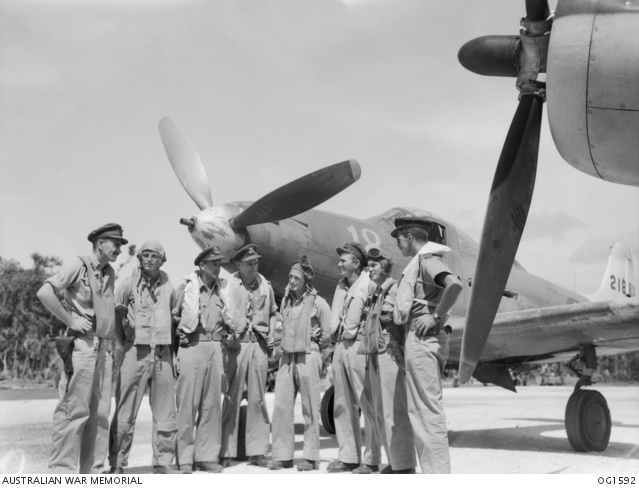
Airacobra P-39N, airfield Tadji near Aitape, New Gwinea 1944
Pilots fighting over New Guinea on the P-400 and P-39 were not likely to score as many victories as their colleagues flying on the P-40, or – later – on the P-47, not to mention the “killing machines” fighting on the P-38. In New Guinea, the most successful Airacobra pilot, Francis E. Dubisher from the 41st Fighter Squadron, scored four of his five victories on the Bell fighter, but only one on a P-400. The other three were gained on the P-39N. The record holders for the P-400 were two pilots from the 39th Fighter Squadron. Thomas J. Lynch shot down three Zeros on the P-400 in May 1942, and went on to score a further seventeen victories on the Lightning. Donald J. Green scored all three of his victories in June 1942 on the P-400.
Check also:
A keen modeller since childhood. He is mainly interested in aviation from the times of the First and Second World Wars. He made about a hundred models, wrote a few books and several dozen articles.
Apart from modeling, he is passionate about history, not only the latest one, but also a very distant one. He loves to read journalism, scientific books and science fiction novels. All the time he grumbles that a day should be 50 hours long and he forces himself to go to sleep.
This post is also available in:
 polski
polski


